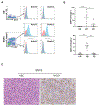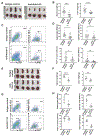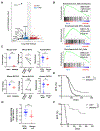Notch Signaling Promotes Mature T-Cell Lymphomagenesis
- PMID: 36006995
- PMCID: PMC9588752
- DOI: 10.1158/0008-5472.CAN-22-1215
Notch Signaling Promotes Mature T-Cell Lymphomagenesis
Abstract
Peripheral T-cell lymphomas (PTCL) are agressive lymphomas that develop from mature T cells. The most common PTCLs are genetically, molecularly, and clinically diverse and are generally associated with dismal outcomes. While Notch signaling plays a critically important role in both the development of immature T cells and their malignant transformation, its role in PTCL is poorly understood, despite the increasingly appreciated function of Notch in regulating the proliferation and differentiation of mature T cells. Here, we demonstrate that Notch receptors and their Delta-like family ligands (DLL1/DLL4) play a pathogenic role in PTCL. Notch1 activation was observed in common PTCL subtypes, including PTCL-not otherwise specified (NOS). In a large cohort of PTCL-NOS biopsies, Notch1 activation was significantly associated with surrogate markers of proliferation. Complementary genetically engineered mouse models and spontaneous PTCL models were used to functionally examine the role of Notch signaling, and Notch1/Notch2 blockade and pan-Notch blockade using dominant-negative MAML significantly impaired the proliferation of malignant T cells and PTCL progression in these models. Treatment with DLL1/DLL4 blocking antibodies established that Notch signaling is ligand-dependent. Together, these findings reveal a role for ligand-dependent Notch signaling in driving peripheral T-cell lymphomagenesis.
Significance: This work demonstrates that ligand-dependent Notch activation promotes the growth and proliferation of mature T-cell lymphomas, providing new therapeutic strategies for this group of aggressive lymphomas.
©2022 American Association for Cancer Research.
Conflict of interest statement
Figures





References
-
- Iqbal J, Wright G, Wang C, Rosenwald A, Gascoyne RD, Weisenburger DD, Greiner TC, Smith L, Guo S, Wilcox RA, Teh BT, Lim ST, Tan SY, Rimsza LM, Jaffe ES, Campo E, Martinez A, Delabie J, Braziel RM, Cook JR, Tubbs RR, Ott G, Geissinger E, Gaulard P, Piccaluga PP, Pileri SA, Au WY, Nakamura S, Seto M, Berger F, de Leval L, Connors JM, Armitage J, Vose J, Chan WC, Staudt LM, Lymphoma Leukemia Molecular Profiling P, the International Peripheral TcLP. Gene expression signatures delineate biological and prognostic subgroups in peripheral T-cell lymphoma. Blood 2014;123:2915–2923. - PMC - PubMed
-
- Wang T, Feldman AL, Wada DA, Lu Y, Polk A, Briski R, Ristow K, Habermann TM, Thomas D, Ziesmer SC, Wellik LE, Lanigan TM, Witzig TE, Pittelkow MR, Bailey NG, Hristov AC, Lim MS, Ansell SM, Wilcox RA. GATA-3 expression identifies a high-risk subset of PTCL, NOS with distinct molecular and clinical features. Blood 2014;123:3007–3015. - PMC - PubMed
-
- Iqbal J, Wilcox R, Naushad H, Rohr J, Heavican TB, Wang C, Bouska A, Fu K, Chan WC, Vose JM. Genomic signatures in T-cell lymphoma: How can these improve precision in diagnosis and inform prognosis? Blood reviews 2016;30:89–100. - PubMed
-
- Heavican TB, Bouska A, Yu J, Lone W, Amador C, Gong Q, Zhang W, Li Y, Dave BJ, Nairismagi ML, Greiner TC, Vose J, Weisenburger DD, Lachel C, Wang C, Fu K, Stevens JM, Lim ST, Ong CK, Gascoyne RD, Missiaglia E, Lemonnier F, Haioun C, Hartmann S, Pedersen MB, Laginestra MA, Wilcox RA, Teh BT, Yoshida N, Ohshima K, Seto M, Rosenwald A, Ott G, Campo E, Rimsza LM, Jaffe ES, Braziel RM, d’Amore F, Inghirami G, Bertoni F, de Leval L, Gaulard P, Staudt LM, McKeithan TW, Pileri S, Chan WC, Iqbal J. Genetic drivers of oncogenic pathways in molecular subgroups of peripheral T-cell lymphoma. Blood 2019;133:1664–1676. - PMC - PubMed
-
- Wang T, Lu Y, Polk A, Chowdhury P, Zamalloa CM, Fujiwara H, Suemori K, Beyersdorf N, Hristov AC, Lim MS, Bailey NG, Wilcox RA. T-cell Receptor Signaling Activates an ITK/NF-kappaB/GATA-3 axis in T-cell Lymphomas Facilitating Resistance to Chemotherapy. Clin Cancer Res 2017;23:2506–2515. - PMC - PubMed
Publication types
MeSH terms
Substances
Grants and funding
LinkOut - more resources
Full Text Sources
Molecular Biology Databases
Miscellaneous

